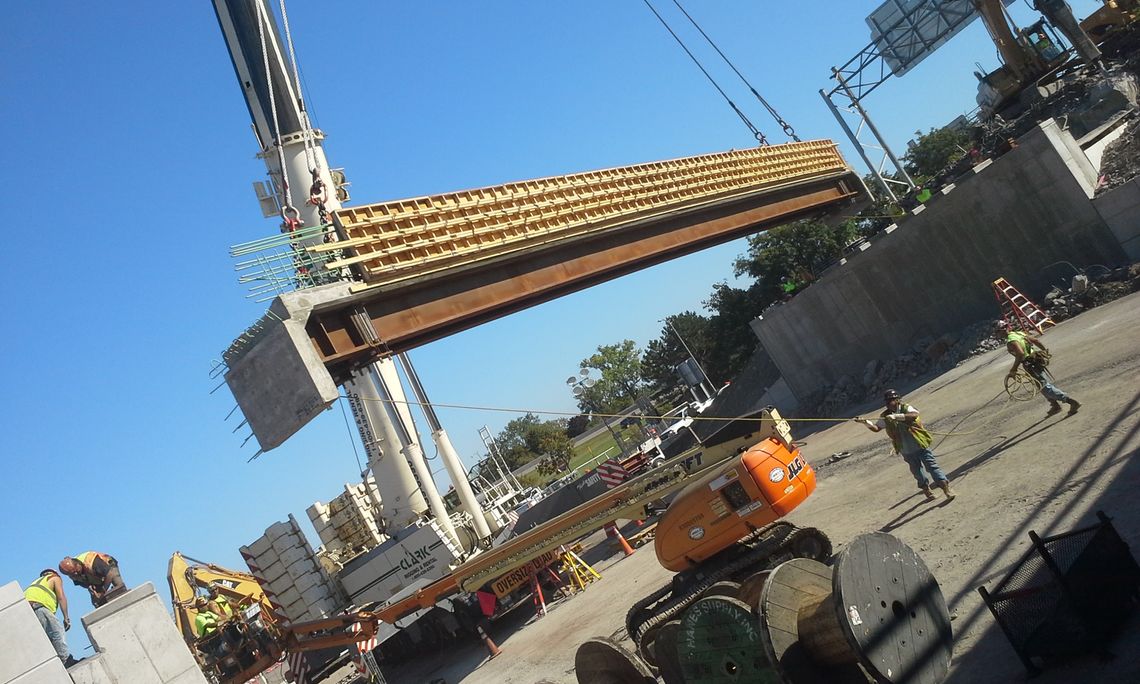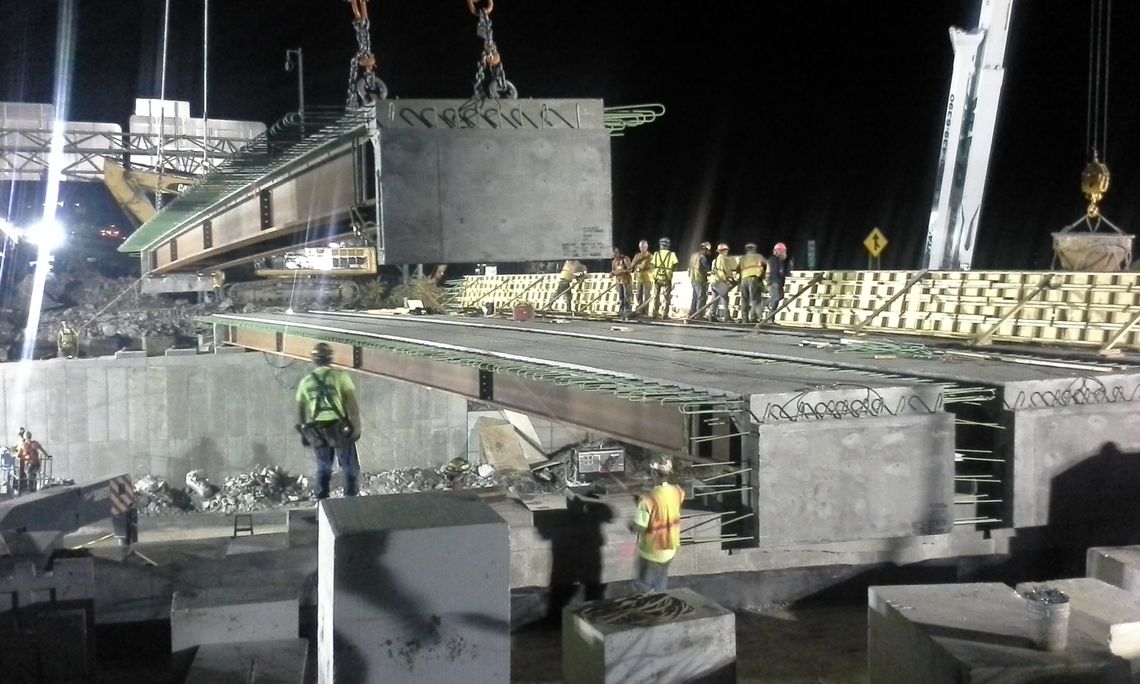ABC

It’s about midnight on a Friday, just outside of the City of Niagara Falls. A cool autumn breeze permeates off of the nearby Niagara River. Tractor-trailers are rumbling across a bridge on I-190 which has reached advanced stages of deterioration. Construction crews are anxiously waiting below on Buffalo Avenue for traffic to be diverted off the bridge and onto the exit and entrance ramps so they can attempt a feat never before accomplished on a New York State Department of Transportation (NYSDOT) project. They will spend the next 72 hours demolishing and reconstructing the bridge so it can be opened back up to traffic in time for Monday’s rush.
According to the Federal Highway Administration, a project of this magnitude, with traditional construction methods, should have taken three months. How were these men and women able to complete the task in only three days? They implemented an increasing popular construction technique called ABC, or Accelerated Bridge Construction.
Accelerated Bridge I-190 over Buffalo Avenue

Owner’s Savings
Accelerated Bridge Construction significantly decreases the duration of on-site bridge construction. Preparation is most vital to the success of ABC, which in the instance of the I-190 Bridge over Buffalo Avenue, included building both the superstructure and substructure concurrently. The precast approach slabs and modular deck beams were cast at a nearby location, only a half mile down the road. With traffic still utilizing the bridge, the new substructure was built behind the existing piers. By completing the bulk of the work before the demolition of the bridge, the contractor was able to efficiently replace the bridge. Within the 72 hour time frame, the crews were able to remove the existing superstructure, pier cap beams, as well as sections of the abutments and approach slabs. They also installed the modular deck beams, backfilled the new abutments with polystyrene blocks, and placed the precast approach slabs.
By using ABC methods, the bridge was reopened within 72 hours.
In a world where time is money, dramatically cutting down on construction duration has tremendous benefits economically. ABC allows owners to temporarily utilize existing infrastructure, such as on and off ramps, to divert traffic around a bridge and back onto the main roadway. As is often the case, there is no need to construct temporary roadways for detours. The limited duration of the construction will have minimal impacts to the wear and tear of diverting traffic onto pre-existing roadways.
By minimizing heavy traffic in general, post-construction repairs will be limited. Local roadways are usually most impacted due to detours on side streets. However, by keeping construction impacts to only a couple of days, wear and tear from increased traffic on local roads will be minimal. ABC also helps eliminate unknown costs such as weather delays and safety risks. The shorter the duration of a project, the less potential risk for weather related delays. Weather delays can cause severe impacts to a schedule, which can be costly to owners. Safety risks are also decreased due to the shortened time workers are exposed to vehicles, equipment, and the elements. It was estimated that approximately two crashes (source) were avoided on I-190 due to the reduction in construction time. This potentially saved the lives of not only construction workers, but highway drivers.
For the overall construction project, it was estimated that by using ABC methods, NYSDOT saved approximately $276,000. It’s important to note that the majority of the savings were passed on to their customers — the users of I-190.
ABC Buffalo Ave01

Moving The Economy
In the instance of the I-190 bridge over Buffalo Avenue, the corridor sees 45,000 vehicles per day, with trucks making up 17% of the traffic. By decreasing the duration of roadway construction, which limits traffic delays — people, goods and services are getting to where they need to go faster. Taking a bridge out of commission for a weekend and reopening it on a Monday before the morning rush, there is little impact to those individuals attempting to get to their jobs, a small business getting their goods to their consumers, or parents picking their kids up from school.
It was estimated that by reducing delays on the NYSDOT project, users saved approximately $2.279 million. This is money that goes directly into the pockets of New York state drivers.
Delays are not the only impacts to the local economy and citizens. Detours can be costly to local businesses, sometimes causing limited access to their storefronts or even forcing businesses to shut down for several weeks when roadways are temporarily closed. Accelerated Bridge Construction minimizes these impacts.
Many road users did not notice that the old, deteriorating bridge has been replaced by a brand-new bridge on Monday morning. Or that their daily drive had become a little smoother and a lot safer. What they would have noticed is 3 months of construction. Thankfully those delays were eliminated thanks to the implementation of the Accelerated Bridge Construction program. It was estimated that by reducing delays on the NYSDOT project, users saved approximately $2.279 million. This is money that goes directly into the pockets of New York state drivers.
On the global scale, Accelerated Bridge Construction keeps us competitive with the world’s economy. At one time, the United States was the epicenter of engineering feats, from the cross-continental railroad, to the American highway system, to the Hoover Dam. Overtime, other countries throughout Europe and Asia have not only been able to go bigger, but they have been able to complete mega projects in short increments of time. ABC proves that America can stay competitive with the rest of the world, by saving both time and money on large infrastructure projects.
ABC Buffalo Ave 02

Environmental Impacts
ABC can also be a vital tool where projects may be located near critical wildlife or endangered species habitats. The reduced construction periods allow work to be scheduled outside of wildlife nesting or breeding seasons, or outside of the spawning periods. Where such species are found there are just a few windows of opportunity where work can be performed so that potential impacts are minimized. ABC enables the work to be performed during the best opportunities. The shorter work durations mean significantly less maintenance requirements for soil and erosion controls.
The shorter durations also reduce detour times and traffic congestion that may be associated with the work, thus helping reduce potential noise and air pollution. According to the TTI 2012 Urban Mobility Report, traffic congestion increases annual carbon dioxide emissions 380 pounds per commuter. NYSDOT was pleased to inform that no significant backups were reported due to the I-190 bridge project, thus saving several pounds of potential carbon dioxide from hitting the atmosphere.
“Simple As Do Re Mi”
Early Monday morning, nearly 72 hours after the bridge has shut down, a tractor trailer roars across the I-190 bridge. It’s an hour or two before the morning rush hour will commence, the sun yet to rise, and the bridge has officially opened to traffic. Exhausted, most of the construction crews are already home asleep while the concrete was left to cure. To the last remaining men and women, they shake hands and share smiles beneath the bridge on Buffalo Avenue. There is a feeling of a grandiose accomplishment that’s much more than an engineering feat. Knowing there’s over 61,000 more structurally deficient bridges just like the one that was replaced, they realize they have experienced a solution to a once very complicated problem.